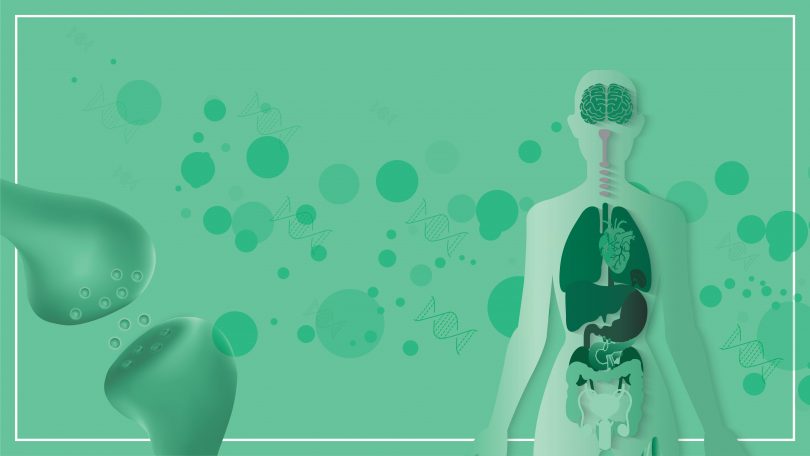Cannabinoid receptors are extremely important to our overall well-being, yet they remain shrouded in mystery. Most people are aware of the fact that cannabis has medicinal value, but how it actually works in the body is less than common knowledge; and it has everything to do with these receptors.
Cannabinoid receptors are a class of G protein-coupled cell membrane receptors that make up part of the endocannabinoid system – which is responsible for a diverse range of physiological functions as well as overall homeostasis.
Cannabinoid receptors are activated by three major groups of molecules: endocannabinoids – which are produced by our own bodies, phytocannabinoids – which come from plants, and synthetic cannabinoids – like the medication Marinol, for example.
As of now, there are two known subtypes of cannabinoid receptors – CB1 and CB2 – although there are believed to be many more. They can be found in different areas throughout the whole body and are present in all mammals, fish, birds, and reptiles, although their signaling is strongest among mammals.
Each type subtype of CB receptors are found in different parts of the body and have a different purpose in the body. Let’s take a closer look.
The Endocannabinoid System
The reason CBD can impact so many different physiological functions is because of the Endocannabinoid System (ECS). The ECS is a network of receptors that can be found throughout our bodies. We naturally create cannabinoids which bond to these receptors to regulate different processes in our bodies and maintain homeostasis.
The ECS helps manage things such as immune function, appetite, sleep wake cycles, pain response, and the list goes on. However, when we are ‘cannabinoid deficient’ our bodies become destabilized and no longer function optimally. This is where supplementing with plant-based cannabinoids (phytocannabinoids) comes into play.
CB1 Receptors
The CB1 receptor is expressed mainly in the brain (central nervous system or “CNS”), but also in the lungs, liver and kidneys. Throughout the brain, varying levels of CB1 expression have been detected in the following regions: the olfactory bulb, cortical regions (neocortex, pyriform cortex, hippocampus, and amygdala), multiple parts of basal ganglia, thalamic and hypothalamic nuclei, and other subcortical regions (e.g., the septal region), cerebellar cortex, and brainstem nuclei.
How it works is that endocannabinoids released by a depolarized neuron bind to CB1 receptors on “pre-synaptic glutamatergic and GABAergic neurons”, resulting in decreased glutamate or GABA release. Restricting glutamate release causes relaxation and limiting GABA release suppresses inhibition, which in turn in energizes the postsynaptic cell.
One of the primary roles of the CB1 receptors is to maintain homeostasis and equilibrium throughout the body, but they’re also an important factor in the treatment of various disorders. It’s believed that the expression of these receptors can help reduce anxiety, minimize pain, and treat inflammatory symptoms.
CB2 Receptors
CB2 receptors are found primarily throughout the immune system and in hematopoietic cells. According to the most up-to-date research, “Through their inhibition of adenylyl cyclase via their Gi/Goα subunits, CB2 receptor agonists cause a reduction in the intracellular levels of cyclic adenosine monophosphate (cAMP).” Simplified, that means these receptors are linked to various immune system functions such as regulating immune suppression, induction of apoptosis, and facilitating cell migration.

CB2 receptors have many important roles, as far as therapeutics go. Shockingly, changes in CB2 receptors have been detected in nearly every disease on earth that affects humans. Although more studies on this subject are needed, theoretically, CB2 receptor activity can be a factor in treating disorders ranging from cardiovascular, gastrointestinal, liver, kidney, psychiatric, bone, skin, autoimmune, lung, pain and even cancer.
It’s also believed that CB2 receptors can be used to treat neurogenerative disorders such as Alzheimer’s disease and dementia. As such, their importance in the overall treatment plan in elderly patients should not be overlooked.
Other Cannabinoid Receptors
It’s been a long-standing hypothesis that additional cannabinoid receptors exist throughout the human body. According to a study published in the Journal of Pharmacological Reviews, “It is now generally accepted that some endocannabinoids, including anandamide, 2-arachidonoyl glycerol and N-arachidonoyl dopamine, as well as Δ9-THC and a number of synthetic CB1/CB2 receptor agonists and antagonists can activate or block established non-CB1, non-CB2 GPCRs, ligand-gated ion channels, ion channels and/or nuclear receptors (PPAR receptors).”
Certain compounds referred to as “abnormal cannabidiol” that produces effects which mimic those of regular cannabinoids but do not activate the documented CB1 and CB2 receptors. This “abnormal cannabidiol” can reduce pain and inflammation, and lower blood pressure just like plant-based CBD. It’s believed that anandamide (which is the first endocannabinoid to be discovered and studied by Israeli Professor Raphael Mechoulam) interacts with the “abnormal cannabidiol” receptor in the Central Nervous System (CNS).
“Importantly, some cannabinoids seem to target these channels or receptors with potencies that differ little from those with which they activate or block CB1 and/or CB2 receptors. Anandamide, such example, displays such potency at T-type voltage-gated calcium channels, voltage-gated KV3.1 and KV4.3 potassium channels, calcium-activated potassium (BK) channels, NMDA receptors, glycine receptors, and allosteric sites on 5-HT3 and nicotinic acetylcholine receptors,” the study further stated.
Another proposed cannabinoid receptor has been discovered in the hippocampus, as well as two possible others in different regions of the brain. These are, however, just theories that have come to fruition based on the activity of these receptors with the endocannabinoid system.
Final Thoughts
If one thing can be gathered from this article, it’s that our bodies are intricate machines that are capable of more than could ever be imagined. Ultimately, the goal of all the functions in our bodies is homeostasis, and as it turns out, cannabis can play a major role in helping us achieve this.
This all thanks to our beautifully complex Endocannabinoid System and the cannabinoid receptors that it interacts with.







